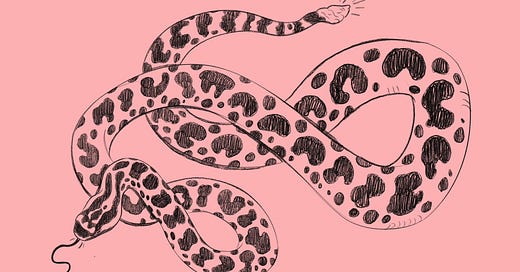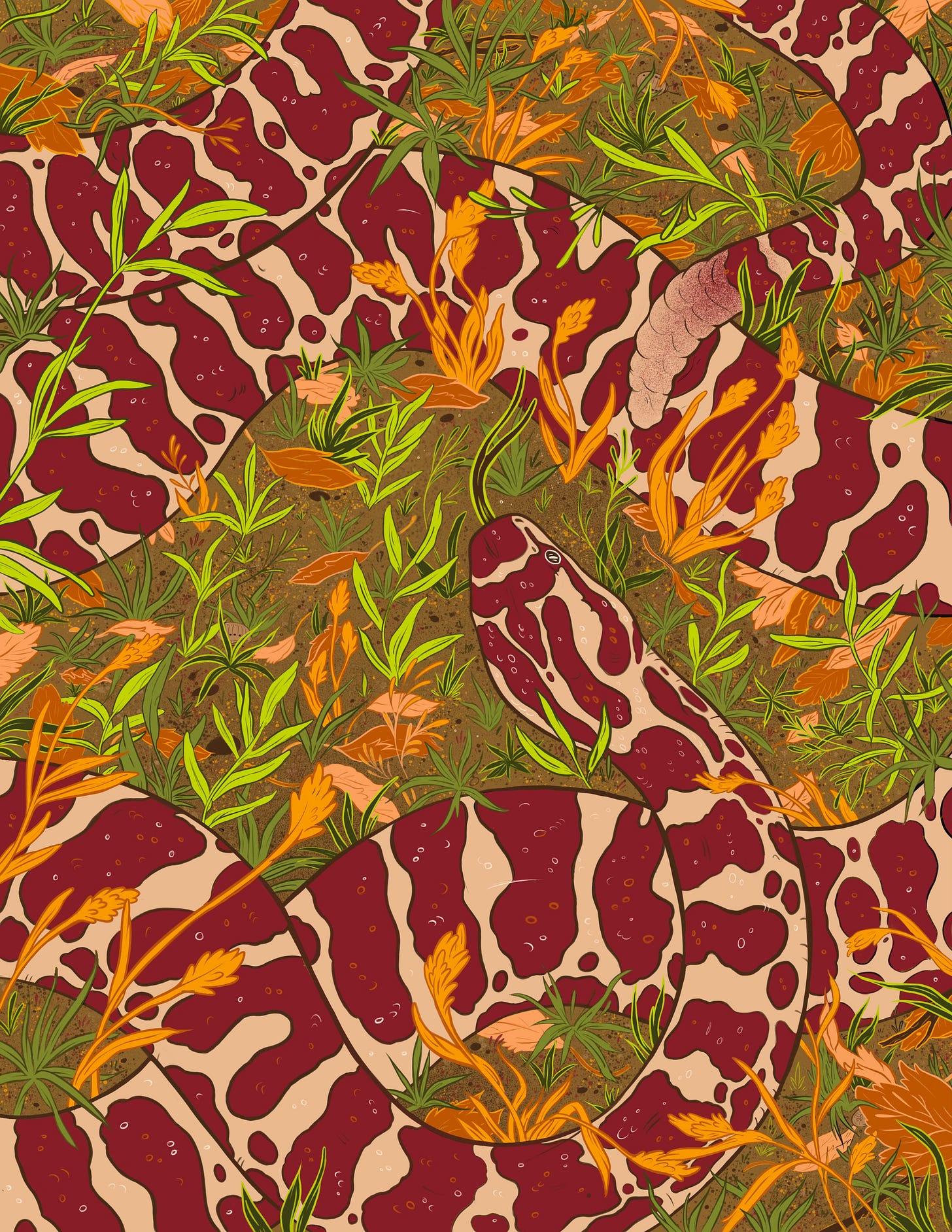Studio Journal no. 10 - The Rattlesnakes in the Gulch
A closer (but safe distance away) look at the Eastern Massasauga rattlesnake.
Hellooo explorers! This week I want to focus on a creature we’ve seen a few times on our journey so far - the Eastern Massasauga rattlesnake. This species can be found in only two spots in New York State, one of which is the Cicero Swamp Management Area, which makes the swamp even more interesting. Growing up near Cicero Swamp I often heard the name ‘Rattlesnake Gulch’ in reference to the area - it was rumored there were ferocious slithering serpents that made drifting off the paved road unsafe. Now while the Eastern Massasauga is not quite the threatening specter they are depicted as, they are pretty cool and mysterious.
The Eastern Massasauga, sistrurus catenatus, is a small rattlesnake found in wet prairies and grasslands, woodlands with sparse trees, and other locales that Cicero Swamp offers. We don’t have a plethora of rattlesnakes within the state, and these rare specimens can be hard to see due to their endangered status. There are actually only two populations left in the state! The species has often been mistaken as the Pygmy Rattlesnake in historical record here; to be clear the Pygmy Rattlesnake, sistrurus miliarius, is a separate species not widely reported here and typically located in the Southeastern United States. The Eastern Massasauga tends to be a snake of smaller stature but rare larger specimens have been found - for example, one snake of about four feet was found within Cicero Swamp (it made the newspaper it was so notable.) Although these are a rare occurrence, the perception of the snake in the area has also largely shaped public perception of Cicero Swamp; enough to earn the nickname Rattlesnake Gulch.
Speaking of perception, the image of the snake as a dangerous, lurking, creature has shaped the view of these snakes into something somewhat mythical in terms of the history of Cicero Swamp. This has contributed to a deep fear and hatred by locals for the snake at different points in history. The degradation of Eastern Massasauga populations as a whole has direct ties to a reputation of danger and negative connotation as dangerous - this perception has led to historical efforts to destroy habitats and get rid of the species.
Contrary to their current rare status, they were once much more common within the area. But many efforts to drive the snake out or destroy populations have decreased their numbers. For example, during a dry summer in Cicero Swamp during 1965, there were increased sightings of the snake because of the change in temperature. As per an article in the Syracuse Herald-Journal, fields were ignited into flame and police searched the area with shotguns, ready to eliminate the snakes. It should be noted that I have searched in my research for records of a snake attack, bite, encounter - the records are few and far between, and I have found nothing recording a deadly encounter. I can’t speak with certainty as I am still digging through records and research, but so far I am still piecing together where the reputation for these snakes could possibly be rooted.
This is not to deny that the snake does not possess the ability to harm; It is notable that the bite is venomous and certainly painful, so it isn’t a snake to poke at (none are really.) But there are warnings; in fact, usually warnings from the snake’s rattling tail occur in a distinct group of three before any attack occurs.
Temperament wise, the Eastern Massasauga is typically not aggressive; they’re actually a bit elusive. They can be difficult to spot and many conversations with locals solidify that they are rarely seen; all people I have spoken to thus far have not seen one. They have distinct markings on their back that are typically dark brown and come in a distinct barred pattern. They blend well with the woody-grassland environments that they dwell in, and records within Cicero Swamp show them basking on rocks within the environment.
Well, that’s our look at our slithering friend. To close our post, I’m working on a small zine as part of my Cicero Swamp work. I’ll offer a closer look at that in a few days, but here is an interesting excerpt I’m referencing on Cicero Swamp, written by Fred E. Dutcher from a newspaper source published on October 31, 1930;
“…It is a great waste place, filled with rabbits, rattlers, huckleberry bushes, moss-covered morasses and everything wild that lives or grows anywhere near this part of the country. Persons who have penetrated into its farthest depths say the wild life there is most surprising and almost unbelievable until seen. From bog to bog it is necessary to go for long distances, where the material on which one stands shakes like a bowl of jelly. Snakes lie on the logs. Ferns and brakes are head high. Cicero Swamp is to Onondaga county what the Everglades are to Florida…”
Farewell for now, explorers! Watch out for rattlers.











Thank you for educating people about the rattlesnakes in the area and for your gorgeous art.